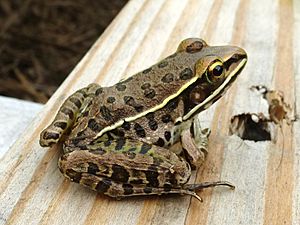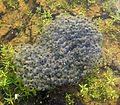Southern leopard frog facts for kids
Quick facts for kids Southern leopard frog |
|
|---|---|
 |
|
| Conservation status | |
| Scientific classification | |
| Genus: |
Lithobates
|
| Species: |
sphenocephalus
|
| Synonyms | |
|
|
The southern leopard frog (Lithobates sphenocephalus or Rana sphenocephala) is a species of true frog. It is native to eastern North America from Kansas to New York to Florida. It is also an introduced species in some areas.
Description
This frog is up to 13 cm long. It is green or brown in color with a yellowish ridge along each side of the back. Rounded dark spots occur on the back and sides; a light spot is seen on each eardrum. The male has larger fore limbs than the female. The breeding male's vocal sacs are spherical when inflated. The call is described as a "ratchetlike trill", "chuckling croak", or a "squeaky balloon-like sound".
The larva is mottled, and the eyes are positioned on the top of the head. It grows to 7.6 cm in length before maturing. The female lays an egg mass that is "baseball-sized" when close to hatching time, and contains up to 1500 eggs.
Ecology and behavior
This frog lives in many types of shallow freshwater habitat and sometimes in slightly brackish water. It is usually found close to water but it can stay on dry land for long periods of time. During warmer months it moves away from the water for most of the time. It is mostly nocturnal, but it can be active during the day and the night, especially during rainfall. It breeds in the winter and spring, and sometimes in the fall; heavy periods of rainfall trigger breeding. The egg mass is connected to aquatic vegetation. It typically nests communally in cooler weather, and individually in warmer weather. Eggs hatch in 4 days to nearly two weeks. The tadpoles take 50 to 75 days to develop to adulthood.
In northern parts of its range it is dormant during the winter months, during which time it remains in well-oxygenated, unfrozen water bodies.
Southern leopard frogs feed primarily on insects, crayfish and other invertebrates. They forage in upland areas during the summer.
Range
This frog is widespread across eastern North America, especially the southeast. It is the most common frog in Florida and in several other regions. It is an introduced species in the Bahamas and at two locations in California. Southern leopard frogs are believed to have been introduced to the Prado Flood Control Basin via a shipment of aquatic fauna to the Chino Gun Club in 1929 or 1930; they are now common in areas of the basin undergoing urbanization. A second established population of the species in California is now suspected, following the March 2016 discovery of two female Southern Leopard Frogs in the San Joaquin River just northwest of Fresno on the border between Madera and Fresno counties.
Subspecies
The subspecies are:
- L. s. sphenocephala – Florida leopard frog
- L. s. utricularia – southern leopard frog
Gallery
- AmphibiaWeb, available at http://amphibiaweb.org/
See also
 In Spanish: Lithobates sphenocephalus para niños
In Spanish: Lithobates sphenocephalus para niños





